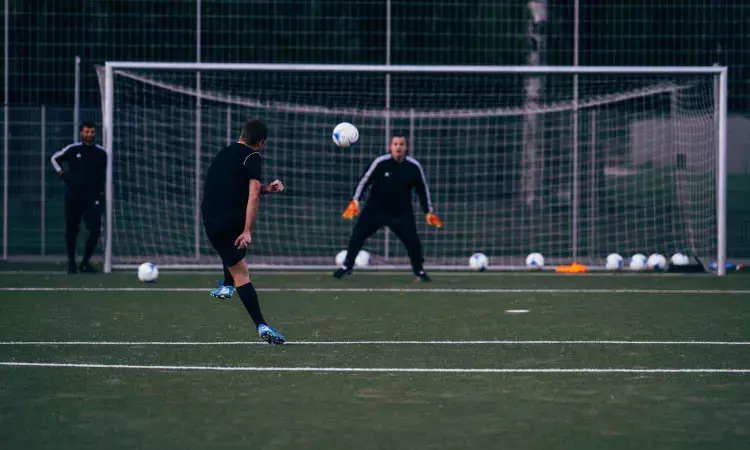- Home
- Medical news & Guidelines
- Anesthesiology
- Cardiology and CTVS
- Critical Care
- Dentistry
- Dermatology
- Diabetes and Endocrinology
- ENT
- Gastroenterology
- Medicine
- Nephrology
- Neurology
- Obstretics-Gynaecology
- Oncology
- Ophthalmology
- Orthopaedics
- Pediatrics-Neonatology
- Psychiatry
- Pulmonology
- Radiology
- Surgery
- Urology
- Laboratory Medicine
- Diet
- Nursing
- Paramedical
- Physiotherapy
- Health news
- Fact Check
- Bone Health Fact Check
- Brain Health Fact Check
- Cancer Related Fact Check
- Child Care Fact Check
- Dental and oral health fact check
- Diabetes and metabolic health fact check
- Diet and Nutrition Fact Check
- Eye and ENT Care Fact Check
- Fitness fact check
- Gut health fact check
- Heart health fact check
- Kidney health fact check
- Medical education fact check
- Men's health fact check
- Respiratory fact check
- Skin and hair care fact check
- Vaccine and Immunization fact check
- Women's health fact check
- AYUSH
- State News
- Andaman and Nicobar Islands
- Andhra Pradesh
- Arunachal Pradesh
- Assam
- Bihar
- Chandigarh
- Chattisgarh
- Dadra and Nagar Haveli
- Daman and Diu
- Delhi
- Goa
- Gujarat
- Haryana
- Himachal Pradesh
- Jammu & Kashmir
- Jharkhand
- Karnataka
- Kerala
- Ladakh
- Lakshadweep
- Madhya Pradesh
- Maharashtra
- Manipur
- Meghalaya
- Mizoram
- Nagaland
- Odisha
- Puducherry
- Punjab
- Rajasthan
- Sikkim
- Tamil Nadu
- Telangana
- Tripura
- Uttar Pradesh
- Uttrakhand
- West Bengal
- Medical Education
- Industry
Sports-Related Orbital Fractures Significant Contributor to Facial Trauma, Predominantly Affect Young Males: Study

USA: Researchers have found in a retrospective cohort study that the highest frequency of sports-related orbital fractures occurred in males (79%) aged 10 to 19 years. Baseball (28.6%) and bicycling (23.1%) were the leading causes. Despite the proven risk, the use of protective eyewear remains low in high-risk sports, emphasizing the need for improved preventive measures.
The study, published in the journal Ophthalmology by Niloufar Bineshfar and colleagues from the Bascom Palmer Eye Institute, University of Miami Miller School of Medicine, analyzed data spanning nearly a decade to explore trends and risks associated with sports-related orbital fractures in the U.S.
Drawing on the National Electronic Injury Surveillance System (NEISS) database from 2014 to 2023, the researchers reviewed incidents of facial trauma involving the orbit, the bony cavity surrounding the eye. A total of 1,468 confirmed cases of sports-related orbital fractures were identified, which translates to a national estimate of approximately 49,765 cases over the study period.
The study led to the following findings:
- The average age of patients with sports-related orbital fractures was 27.1 years.
- The highest number of injuries occurred among adolescents aged 10 to 19 years.
- Males accounted for nearly 80% of the cases.
- Baseball and bicycling were the leading causes of these injuries, followed by softball.
- The orbital floor was the most commonly fractured site, involved in nearly 60% of all cases.
- This susceptibility of the area reflects the impact of blunt trauma from sports involving projectiles or falls.
- Among 865 cases from 2019 to 2023 with secondary injury data, about 14% had additional eye or periocular injuries.
- Reported complications included eyelid lacerations (17.6%), corneal abrasions (13.4%), and hyphema (9.2%).
The authors stressed that while these injuries can lead to significant functional and cosmetic issues, their prevalence remains underestimated due to the limited use of protective gear. Notably, many of the high-risk sports linked to these fractures — such as baseball and cycling — lack widespread enforcement or adoption of protective eyewear.
Given the serious nature of orbital and associated ocular injuries, the researchers call for greater awareness and implementation of preventive strategies. These may include mandating sport-specific protective equipment and instituting stronger safety protocols for youth and amateur sports.
The authors concluded, "The study highlights the public health relevance of sports-related orbital trauma, particularly among young male athletes. Addressing the current gap in preventive measures could significantly reduce the burden of these injuries and protect vision health in vulnerable populations."
Reference:
Bineshfar N, Shields C, Davila N, McLaughlin SA, Pradeep T, Lee WW. The Epidemiology of Sports-related Orbital Fractures in the United States. Ophthalmology. 2025 Jun 21:S0161-6420(25)00386-0. doi: 10.1016/j.ophtha.2025.06.016. Epub ahead of print. PMID: 40550362.
Dr Kamal Kant Kohli-MBBS, DTCD- a chest specialist with more than 30 years of practice and a flair for writing clinical articles, Dr Kamal Kant Kohli joined Medical Dialogues as a Chief Editor of Medical News. Besides writing articles, as an editor, he proofreads and verifies all the medical content published on Medical Dialogues including those coming from journals, studies,medical conferences,guidelines etc. Email: drkohli@medicaldialogues.in. Contact no. 011-43720751


